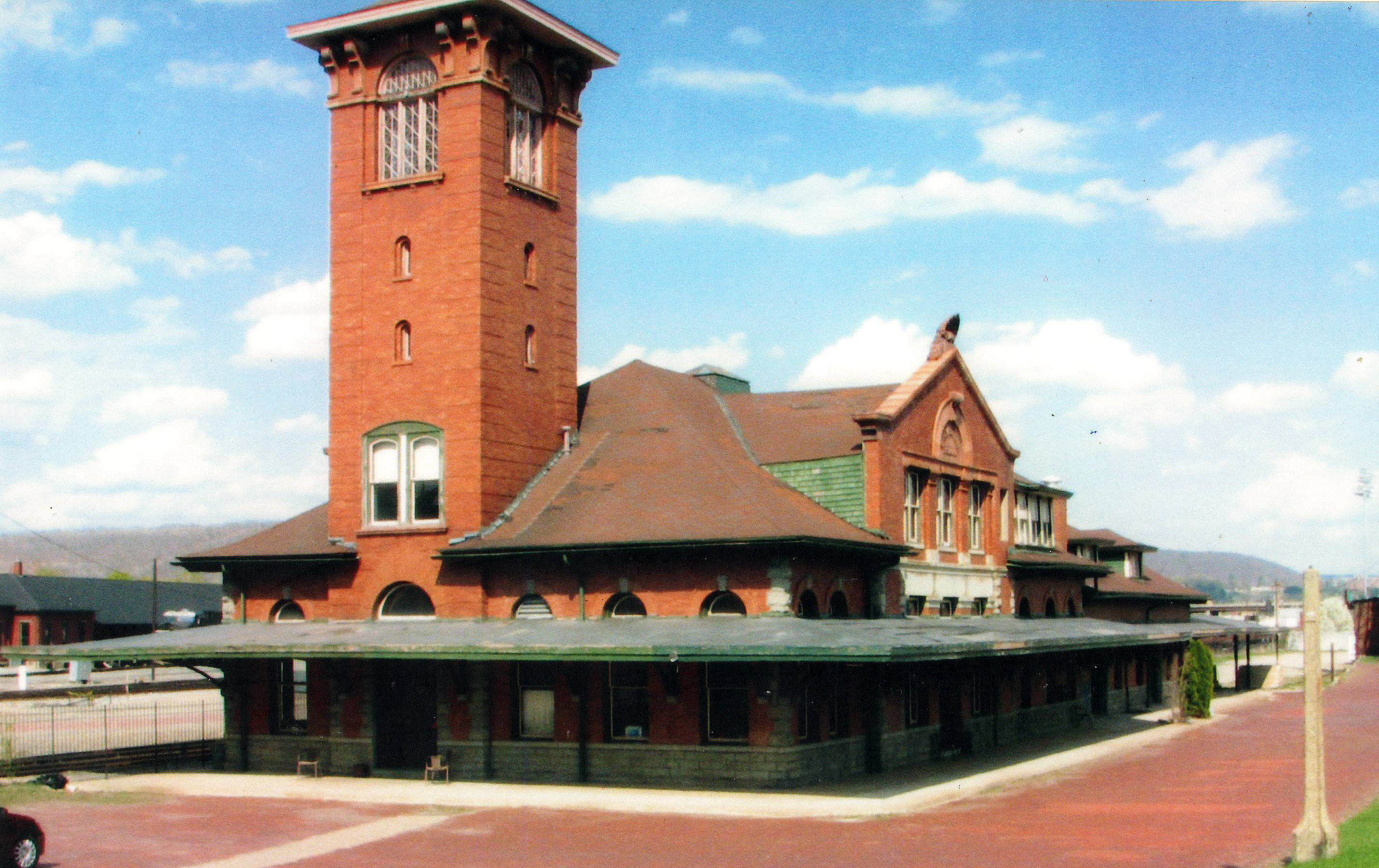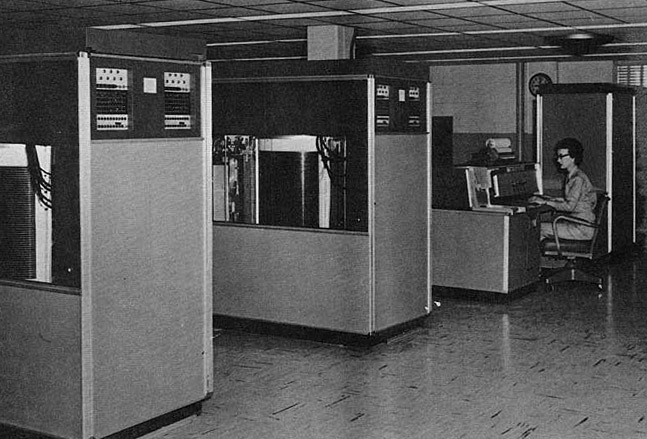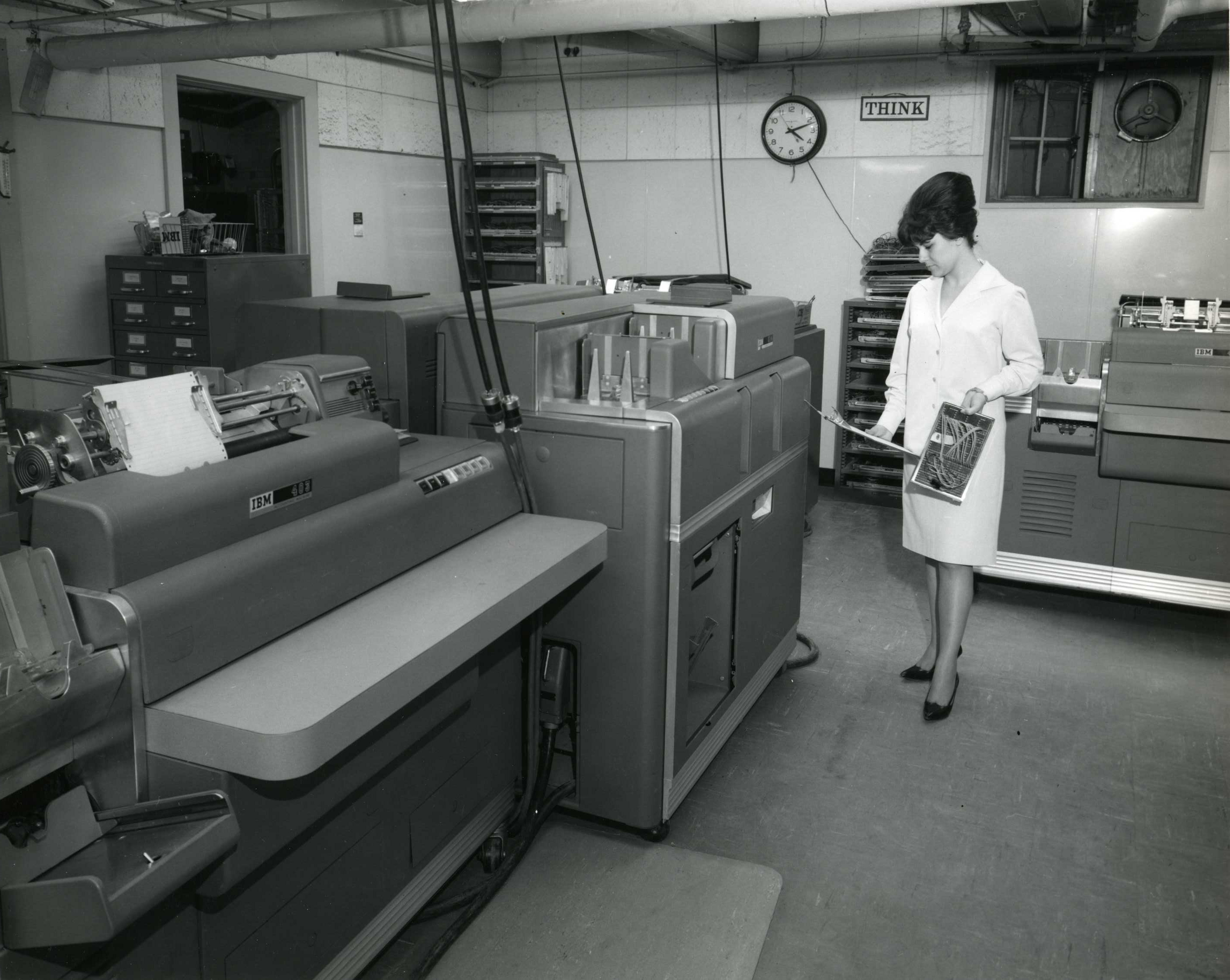|
IBM 1440
The IBM 1440 computer was announced by IBM October 11, 1962. This member of the IBM 1400 series was described many years later as "essentially a lower-cost version of the 1401," and programs for the 1440 could easily be adapted to run on the IBM 1401. Despite what IBM described as "special features ... to meet immediate data processing requirements and ... to absorb increased demands," the 1440 didn't quite attain the same commercial success as the 1401, and it was withdrawn on February 8, 1971. Author Emerson Pugh wrote that the 1440 "did poorly in the marketplace because it was initially offered without the ability to attach magnetic tape units as well." (referring to offering both tape and disk). System configuration The IBM 1441 processing unit ( CPU) contained arithmetic and logic circuits and up to 16,000 alphanumeric storage positions. The console was either a Model 1 or, when an electric typewriter was added, a Model 2, of the IBM 1447 operator's console. Periphera ... [...More Info...] [...Related Items...] OR: [Wikipedia] [Google] [Baidu] |
IBM 1400
The IBM 1400 series were second-generation (transistor) mid-range business decimal computers that IBM marketed in the early 1960s. The computers were offered to replace tabulating machines like the IBM 407. The 1400-series machines stored information in magnetic cores as variable-length character strings separated on the left by a special bit, called a "wordmark," and on the right by a "record mark." Arithmetic was performed digit-by-digit. Input and output support included punched card, magnetic tape, and high-speed line printers. Disk storage was also available. Many members of the series could be used as independent systems, as extensions to IBM punched-card equipment, or as auxiliary equipment to other computer systems. Some, however, were intended for specific applications or were economical only as independent systems. History The 1401, announced on October 5, 1959, was the first member of the IBM 1400 series. It was the first computer to deploy over 10,000 units. The ... [...More Info...] [...Related Items...] OR: [Wikipedia] [Google] [Baidu] |
Binghamton, New York
Binghamton () is a city in the U.S. state of New York, and serves as the county seat of Broome County. Surrounded by rolling hills, it lies in the state's Southern Tier region near the Pennsylvania border, in a bowl-shaped valley at the confluence of the Susquehanna and Chenango Rivers. Binghamton is the principal city and cultural center of the Binghamton metropolitan area (also known as Greater Binghamton, or historically the Triple Cities, including Endicott and Johnson City), home to a quarter million people. The city's population, according to the 2020 census, is 47,969. From the days of the railroad, Binghamton was a transportation crossroads and a manufacturing center, and has been known at different times for the production of cigars, shoes, and computers. IBM was founded nearby, and the flight simulator was invented in the city, leading to a notable concentration of electronics- and defense-oriented firms. This sustained economic prosperity earned Binghamton the mon ... [...More Info...] [...Related Items...] OR: [Wikipedia] [Google] [Baidu] |
Iron Curtain
The Iron Curtain was the political boundary dividing Europe into two separate areas from the end of World War II in 1945 until the end of the Cold War in 1991. The term symbolizes the efforts by the Soviet Union (USSR) to block itself and its satellite states from open contact with the West, its allies and neutral states. On the east side of the Iron Curtain were the countries that were connected to or influenced by the Soviet Union, while on the west side were the countries that were NATO members, or connected to or influenced by the United States; or nominally neutral. Separate international economic and military alliances were developed on each side of the Iron Curtain. It later became a term for the physical barrier of fences, walls, minefields, and watchtowers that divided the "east" and "west". The Berlin Wall was also part of this physical barrier. The nations to the east of the Iron Curtain were Poland, East Germany, Czechoslovakia, Hungary, Romania, Bulgaria, Albania, ... [...More Info...] [...Related Items...] OR: [Wikipedia] [Google] [Baidu] |
Orlando Winfield Wilson
Orlando Winfield Wilson (May 15, 1900 – October 18, 1972), also known as O. W. Wilson, was an American police officer, later becoming a leader in policing along with authoring several books on policing. Wilson served as Superintendent of the Chicago Police Department, chief of police in Fullerton, California and Wichita, Kansas. Background Early life and career Wilson was born on May 15, 1900, in Veblen, South Dakota, and moved with his family to California. In 1921, Wilson enrolled in the University of California, Berkeley, majoring in criminology and studying under August Vollmer. Wilson graduated in 1924, with a Bachelor of Arts degree. While at Berkeley, he also worked as a police officer with the Berkeley Police Department; such education for a police officer was rare at the time. During World War II, Wilson served as a provost marshal with the U.S. Army and retired from the service with the rank of full colonel in the military police. Wilson remained in Europe until 1947 ... [...More Info...] [...Related Items...] OR: [Wikipedia] [Google] [Baidu] |
Chicago Police Department
The Chicago Police Department (CPD) is the municipal law enforcement agency of the U.S. city of Chicago, Illinois, under the jurisdiction of the City Council. It is the second-largest municipal police department in the United States, behind the New York City Police Department. CPD currently has 11,710 sworn officers on duty, and over 1,925 other employees. Tracing its roots back to the year of 1835, the Chicago Police Department is one of the oldest modern police departments in the world. The Chicago Police Department has a history of police brutality, particularly targeting the African-American community in Chicago. In 2017, the United States Department of Justice strongly criticized the department for poor training, lack of oversight and routine use of excessive force. Department structure Office of the Superintendent The Superintendent of Police leads the Chicago Police Department. David O. Brown, former Chief of the Dallas Police Department, is the current Superin ... [...More Info...] [...Related Items...] OR: [Wikipedia] [Google] [Baidu] |
Input/Output Control System
Input/Output Control System (IOCS) is any of several packages on early IBM entry-level and mainframe computers that provided low level access to records on peripheral equipment. IOCS provides functionality similar to 1960s packages from other vendors, e.g., File Control Processor (FCP) in RCA 3301 Realcom Operating System, GEFRC in GECOS, and to the later Record Management Services (RMS) in DEC VAX/VMS (later OpenVMS.) Computers in the 1950s and 1960s typically dealt with data that were organized into records either by the nature of the media, e.g., lines of print, or by application requirements. IOCS was intended to allow Assembler language programmers to read and write records without having to worry about the details of the various devices or the blocking of logical records into physical records. IOCS provided the run time I/O support for several compilers. Computers of this era often did not have operating systems in the modern sense. Application programs called IOCS routi ... [...More Info...] [...Related Items...] OR: [Wikipedia] [Google] [Baidu] |
Assembly Language
In computer programming, assembly language (or assembler language, or symbolic machine code), often referred to simply as Assembly and commonly abbreviated as ASM or asm, is any low-level programming language with a very strong correspondence between the instructions in the language and the architecture's machine code instructions. Assembly language usually has one statement per machine instruction (1:1), but constants, comments, assembler directives, symbolic labels of, e.g., memory locations, registers, and macros are generally also supported. The first assembly code in which a language is used to represent machine code instructions is found in Kathleen and Andrew Donald Booth's 1947 work, ''Coding for A.R.C.''. Assembly code is converted into executable machine code by a utility program referred to as an ''assembler''. The term "assembler" is generally attributed to Wilkes, Wheeler and Gill in their 1951 book ''The Preparation of Programs for an Electronic Digital Com ... [...More Info...] [...Related Items...] OR: [Wikipedia] [Google] [Baidu] |
Disk Drive
Disk storage (also sometimes called drive storage) is a general category of storage mechanisms where data is recorded by various electronic, magnetic, optical, or mechanical changes to a surface layer of one or more rotating disks. A disk drive is a device implementing such a storage mechanism. Notable types are the hard disk drive (HDD) containing a non-removable disk, the floppy disk drive (FDD) and its removable floppy disk, and various optical disc drives (ODD) and associated optical disc media. (The spelling ''disk'' and ''disc'' are used interchangeably except where trademarks preclude one usage, e.g. the Compact Disc logo. The choice of a particular form is frequently historical, as in IBM's usage of the ''disk'' form beginning in 1956 with the " IBM 350 disk storage unit".) Background Audio information was originally recorded by analog methods (see Sound recording and reproduction). Similarly the first video disc used an analog recording method. In the music indu ... [...More Info...] [...Related Items...] OR: [Wikipedia] [Google] [Baidu] |
IBM 1401
The IBM 1401 is a variable-wordlength decimal computer that was announced by IBM on October 5, 1959. The first member of the highly successful IBM 1400 series, it was aimed at replacing unit record equipment for processing data stored on punched cards and at providing peripheral services for larger computers. The 1401 is considered to be the Ford Model-T of the computer industry, because it was mass-produced and because of its sales volume. Over 12,000 units were produced and many were leased or resold after they were replaced with newer technology. The 1401 was withdrawn on February 8, 1971. History The 1401 project evolved from an IBM project named World Wide Accounting Machine (WWAM), which in turn was a reaction to the success of Bull Gamma 3 (fr). The 1401 was operated as an independent system, in conjunction with IBM punched card equipment, or as auxiliary equipment to IBM 700 or 7000 series systems. Monthly rental for 1401 configurations started at US$2,500 (wort ... [...More Info...] [...Related Items...] OR: [Wikipedia] [Google] [Baidu] |
IBM 1311
IBM manufactured magnetic disk storage devices from 1956 to 2003, when it sold its hard disk drive business to Hitachi. Both the hard disk drive (HDD) and floppy disk drive (FDD) were invented by IBM and as such IBM's employees were responsible for many of the innovations in these products and their technologies. The basic mechanical arrangement of hard disk drives has not changed since the IBM 1301. Disk drive performance and characteristics are measured by the same standards now as they were in the 1950s. Few products in history have enjoyed such spectacular declines in cost and physical size along with equally dramatic improvements in capacity and performance. IBM manufactured 8-inch floppy disk drives from 1969 until the mid-1980s, but did not become a significant manufacturer of smaller-sized, 5.25- or 3.5-inch floppy disk drives (the dimension refers to the diameter of the floppy disk, not the size of the drive). IBM always offered its magnetic disk drives for sale but did no ... [...More Info...] [...Related Items...] OR: [Wikipedia] [Google] [Baidu] |
IBM 1443
The IBM 1443 Printer (sometimes referred to as the ''1443 Flying Type Bar Printer'') is an obsolete computer line printer used in the punched card era. It was offered in three models: Models 1, 2 and N1; the last two could print up to 240 lines per minute (LPM) with a full character set. The 1443 was initially introduced October 11, 1962 for use with the IBM 1440 system and withdrawn February 8, 1971. It was announced in 1963 for the 1620 system. The printer could also be used on the IBM 1620 (announced 1963), IBM 1710, IBM 1800 and System/360. Decades later IBM recycled the 1443 model number to refer to a different product. Technology Beginning in 1920, IBM developed a series of printers * IBM 405 - introduced in 1934 - top speed was 80 lines per minute. * IBM 402 - introduced after World War II - printed as many as 100 lines per minute. These IBM printers, as did others of the early punched card era, use "type bars," originally developed for their line of accounting machi ... [...More Info...] [...Related Items...] OR: [Wikipedia] [Google] [Baidu] |






